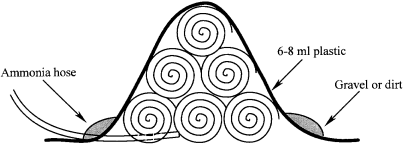 Reviewed April 26, 2006
Reviewed April 26, 2006
AMMONIATION OF CROP RESIDUE FOR
IMPROVED FEEDING VALUE IN BEEF COWS
Bob L. Larson, DVM, PhD
University of Missouri, Commercial Agriculture
In order for the cost of production of beef cattle to remain competitive with other protein sources, feed costs must be minimized by utilizing low quality forages. A very economically rewarding practice to lower feed costs in wintering rations of brood cows is to replace more expensive feeds such as grass hays with less expensive feeds such as crop residues that have been ammoniated to increase their nutrient content.
How does ammonia treatment improve forage feeding value?
- It increases digestibility of crop residues by breaking down lignin-cellulose bonds in the plant fiber. Ammoniation also solubilizes plant carbohydrate and improves dry matter digestion by swelling the plant tissue.
- Treatment of crop residues with ammonia improves the palatability over non-treated residues, so feed intake is increased 15-20%.
- Ammonia treatment usually doubles crude protein content and serves as an excellent source of non-protein nitrogen (NPN) which is well utilized by calves and brood cows.
- This treatment also preserves forage that is 25-30% moisture. It is an excellent fungicide and prevents heating.
* The Maillard reaction (a non-enzymatic browning reaction) = when straw takes up anhydrous ammonia and becomes more digestible and more palatable, the protein content increases, and the color changes from golden yellow to brown.
% Protein % Digestibility Increased
------------------ ------------------ ---------
Residue Control Treated Control Treated Intake
------- ------- ------- ------- ------- ------
Wheat Straw 3.7 9.7 38.9 48.0 18%
Corn Stover 6.2 11.0 48.0 56.2 22%
We do not recommend treating higher quality grass hays such as brome, fescue, small grains, forage sorghum or sudan. The high carbohydrate content of these forages combine with ammonia to produce compounds (4-methylimidazole and pyrazines) that cause hyperactivity, convulsions and even death, especially when treated forage makes up most or all of the ration.
Treating Dry Forages With Anhydrous Ammonia
- Can be applied to any forage package - square or large round bales, loafs, loose stacks, etc.
- Best to apply soon after harvest to prevent weathering and feed loss:
Warm weather speeds up treatment effect (3-7 days)
Can be applied during cold weather, but takes longer (30-45 days)
- Forage must be covered with plastic to seal in ammonia:
- Group bales or stacks together for efficient plastic use.
- Select a level site with wind protection if possible
- If available, a bunker or pit silo is a good site
- Cover with 6-8 mil black or UV resistant clear plastic
- Seal well around edges with dirt, gravel, etc.
- Plastic is not needed under the forage
- Example: 1 roll of 40' X 100' plastic will cover a 6 bale pyramid stack, 14-15 bales long (84-90 bales)
- Apply about 3% (60 lb/ton) ammonia to forage:
- Apply ammonia through hose or pipe sealed under plastic at the center of the stack
* Use 1" plastic pipe with holes drilled in it
- Use regulator or gauge for accurate application, or order a nurse tank with only the amount of ammonia needed for treatment.
- Apply ammonia slowly to minimize ballooning of plastic - 10-60 lbs. of ammonia per minute works well (take 6-8 hours to ammoniate)
- During application, some of the ammonia will turn to a cold liquid - a depression or trench under the stack will help to contain it.
- The gaseous ammonia will balloon the plastic for 1-4 hours.
- Make sure equipment is in good shape, work upwind and handle ammonia safely.
- Do not ammoniate on hot days (>95 degrees F) - forage will take up too much ammonia.
- Keep covered for at least 5 to 45 days, depending on temperature
- Best to leave covered until about ready to feed to prevent weathering.
- Uncover 3-7 days prior to feeding to allow residual ammonia to escape.
- Can be tub ground before feeding without loss of treatment effect.
- Supplement with minerals, Vitamin A, etc. as needed
- If forage is to be analyzed for crude protein, label the sample "ammonia treated" so the lab can analyze it correctly.

Fike GD, Simms DD, Cochran RC, Vanzant ES, Kuhl GL, Brandt RT. Protein supplementation of ammoniated wheat straw: Effect on performance and forage utilization of beef cattle. J Anim Sci 73:1595-1601; 1995.
Ammoniated wheat straw is an acceptable "base" forage for pregnant beef cows. However, cow body weight and condition can be improved by feeding grain-based supplements in conjunction with ammoniated wheat straw. Increasing the protein concentration in grain-based supplements (20 to 30% CP) fed to cows consuming ammoniated wheat straw will improve the response to supplementation. Enhanced performance seems to be, at least partly, a response to increased digestibile dry matter.
Back to MU Drought site
|

 Reviewed April 26, 2006
Reviewed April 26, 2006

